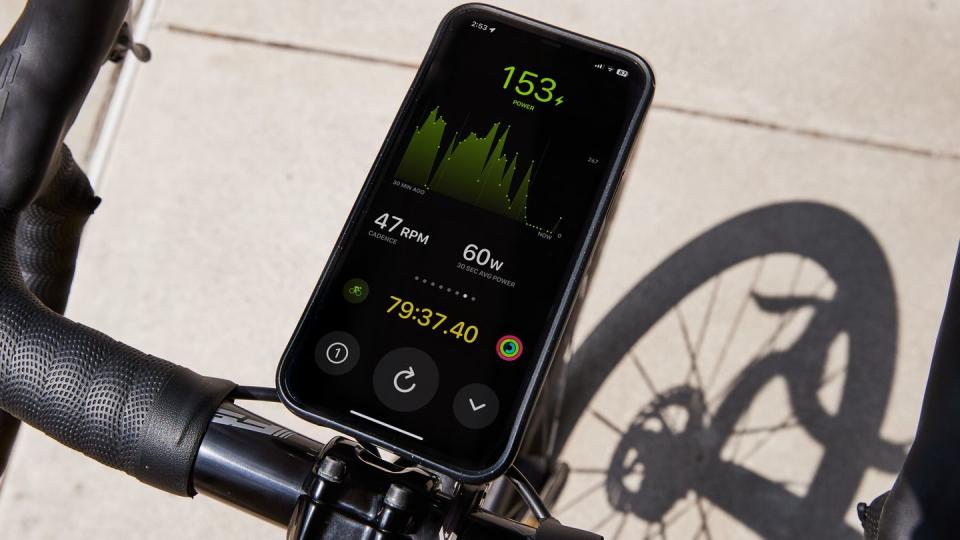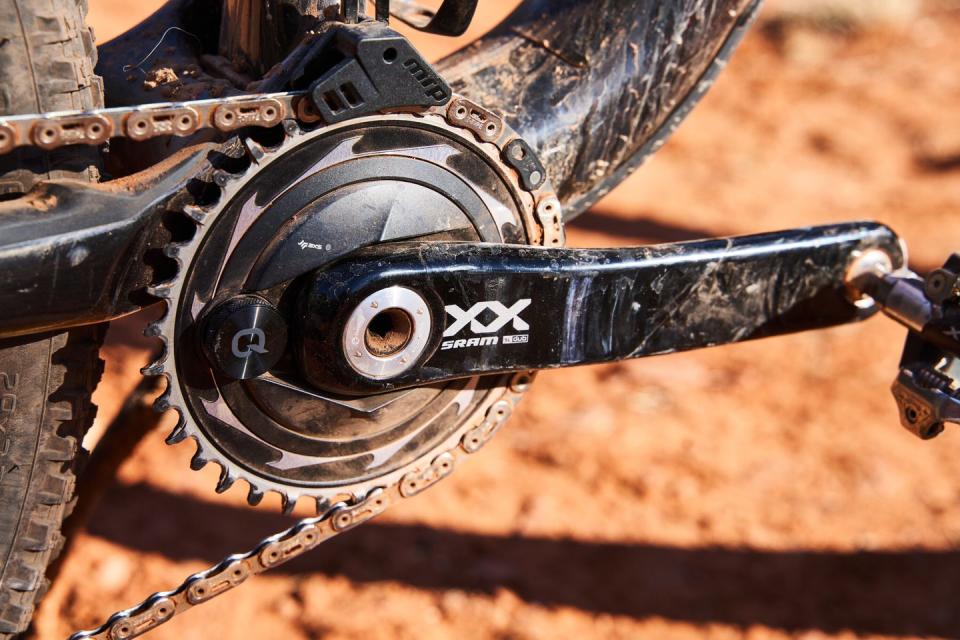Do You Really Need a Power Meter?

Ultimately, a power meter can be an extremely helpful training tool—that is, if you’re actually going to use the data to make changes and track progress. But there are a few things you should think about before hitting “buy now” on this somewhat pricey device.
So we asked cycling coaches to weigh in on whether it’s time for you to invest in a power meter, depending on your fitness level and your goals.
What is a power meter?
A power meter is a crank, wheel, or pedal-based device that measures the watts you produce as you pedal your bike. Simply put, it’s an objective measure of the work you’re doing on the bike.
While 20 years ago, power meters were in their infancy and were bulky and expensive, today, there are great lightweight options available for under $500.
“A power meter helps you determine where your strengths and weaknesses are as a rider,” explains cycling coach Lucas Wall of Develo Coaching. “It helps you see if the training you’re doing is actually effective. I’ve had riders who don’t respond to certain types of training, and having that data allows us to tweak their training to find what does work.”

Who needs a power meter?
If you’re riding consistently, doing structured workouts, and want to develop as a rider, a power meter will help you make a roadmap for your training and track your progress, says Wall. If you’re working with a coach, a power meter becomes even more valuable, because the coach can use your heart rate data and power data to plan your training. (If you have a remote coach, a power meter is critical, says Wall, as it’s very hard for a virtual coach to understand how your training is progressing without that data.)
However, many experts will recommend you train without a power meter when you’re first starting out. “I wouldn’t suggest a power meter until a cyclist has reached the point where they understand heart rate and perceived exertion as metrics they measure during rides,” says Ryan Kohler of Rocky Mountain Devo. “They should be familiar with heart rate already, because heart rate is the response variable, power is just the objective measure of output. So a rider should be able to look at heart rate and understand what it means for them, and link it to their perceived exertion or how they’re feeling. From there, then power is helpful to quantify the work that you’ve done and link that work directly to your effort.”
This maturity and understanding, as Kohler refers to it, helps cyclists not stress out about what their power numbers are, and allows them to have a deeper understanding of it and how it connects to their feeling.
“When you have already trained for a few seasons, you have a great performance-enabling environment setup around you with a good structured training plan and perhaps a knowledgeable coach who can help you make actual use of the power meter instead of just obsessing over numbers and getting frustrated when they don’t go your way all the time,” says Christian Eilers, a youth coach and longtime cyclist in Ontario, Canada.
Now, if you love tech and you really, really want a power meter, there’s nothing wrong with that. The nice thing about having a power meter, even if you’re a newer cyclist, is that you’re building a collection of data that—even if you’re not using it right now—can show you trends of your progress later on. “Ultimately, the information you can get even if you don’t know what to do with it will be helpful down the road, if you want to take your cycling seriously,” says Wall.
Who doesn’t need a power meter?
Eilers says he would have recommended everyone have a power meter a few years ago, but has learned a lot more goes into deciphering the data, which means they’re not right for everyone. “I would now say a cyclist should get a power meter when they have trained and improved for a few seasons and they are sure they have reached a point where they won’t get performance gains without it,” he explains.
Other than feeling a gnawing sense of despair when it appears that your functional threshold power (FTP) is really, really low right now, there are a few minor downsides to power meters.
First and foremost, it’s important to remember that while power is a big part of cycling, skills and tactics go a long, says Wall. If you can corner smoother and faster than the rest of the guys in the pack and use less brake, then you don’t need the extra power to stay in the peloton. Often, when cyclists first get a power meter, they get a bit obsessed with the numbers and forget about the other qualities that make a cyclist great.
The other downside is the price tag. Yes, power meters have come down in cost, but they are yet another spend that feels almost necessary if one wants to be taken “seriously” as a cyclist. But you heard it here first: Having a power meter doesn’t make you a more serious cyclist than the guy next to you who doesn’t have one.
Too often, us cyclists get bogged down in the gear needs, and forget about the important part—that is, just making time to pedal your bike. So consider this your reminder that you can’t buy power, you can only buy a thing that measures it.
To make a power meter worth the spend, you need to use the data that it provides. That means you need a cycling computer that can sync to your power meter and display the data, then store it for uploading later. If you’re not already logging rides on a platform like TrainingPeaks that brings in your heart rate and power data from your cycling computer (or you don’t have a coach looking at that data for you), you likely don’t have much need for a power meter.
Power meters are also less helpful for off-road disciplines like cyclocross and mountain biking. They can be great training tools, but if you ride on muddy, wet trails often and need to spray your bike down frequently, the wear and tear on your power meter may shorten its lifespan.
Beyond that, because the nature of these disciplines is very on and off, your power is going to be extremely inconsistent in any given ride. If you’re trying to do an endurance mountain bike ride, for example, you’re better off focusing on your heart rate and trying to keep it as close to your endurance heart rate zone as possible versus focusing on power as you navigate steep climbs, gnarly descents, and twisty corners.
Finally, young riders likely don’t need power meters. “I find it’s a dangerous tool for the cycling version of ‘hockey parents’ who might be following their children's progress on Strava and start saying things like, ‘X has put out Y watts for this and that long, you need to train harder,’ or ‘wow, M now has an FTP of N watts, you need to step up.’ It can ruin the fun in cycling by turning the sport into a numbers game,” says Eilers. He’s seen it happen and lead to burnout in youth cyclists—and he says that with young athletes, learning to understand perceived exertion is much more important than any number on a screen.
Should I get a power meter or a smart trainer?
“Most people today are actually coming into training with an understanding of power from their smart trainer, versus coming to indoor training after riding outside,” says Wall. “The smart trainer definitely provides valuable feedback with power information, and of course, it’s great for those of us who need to spend chunks of the year riding indoors.”
A lot of riders are actually paying attention to indoor power these days, thanks to the rise of smart trainers and the affordability of many of the options out there. Wahoo’s Kickr Core is $500—and that not only monitors and controls your power output, it’s also a great indoor stationary trainer. So, compared to a standalone power meter, it’s actually quite a bargain.
If you don’t already have an indoor trainer or a power meter and you want both, it’s arguably a better use of your cash to buy a smart trainer, then eventually add a power meter for outdoor riding.
Smart trainers are also potentially a better option for newer riders since they allow riders to do more than just focus on numbers.
However, there is a caveat: Your power indoors is unlikely to match what you produce outdoors. “Some people will claim your power meter accuracy is part of that. But I think we’ve come to understand that there’s an indoor training effect,” Wall says. “Inside, you often don’t put out as much power at threshold, and you’re unable to really use the bike and move around in a sprint, so your power is lower.”
What metrics should I focus on if I don’t have a power meter?
If you’ve decided a power meter isn’t worth the investment, you can still track your progress with other metrics. Heart rate and perceived exertion are both great performance metrics, and if you want to tie them to another metric to measure your progress, speed and VAM (velocità ascensionale media, or average ascent speed) are great options that your GPS can track.
For example, you can ride a 10-mile stretch of road at your tempo zone heart rate and measure how long it takes/what your speed is for the 10 miles. Then, a month later, you can do the same test and see if your speed has improved.
“Speed is a great one, especially for a beginner. Obviously, things like wind, temperature and weather are factors that can impact speed, but it’s still a great starting point,” says Kohler. “I have a lot of success with athletes who live in mountainous areas using VAM instead of power if they don’t have access to a power meter. We’re able to see how many peters per hour the rider is climbing, and we can estimate power pretty well based on that metric. It’s a fantastic surrogate for power.”
You Might Also Like

